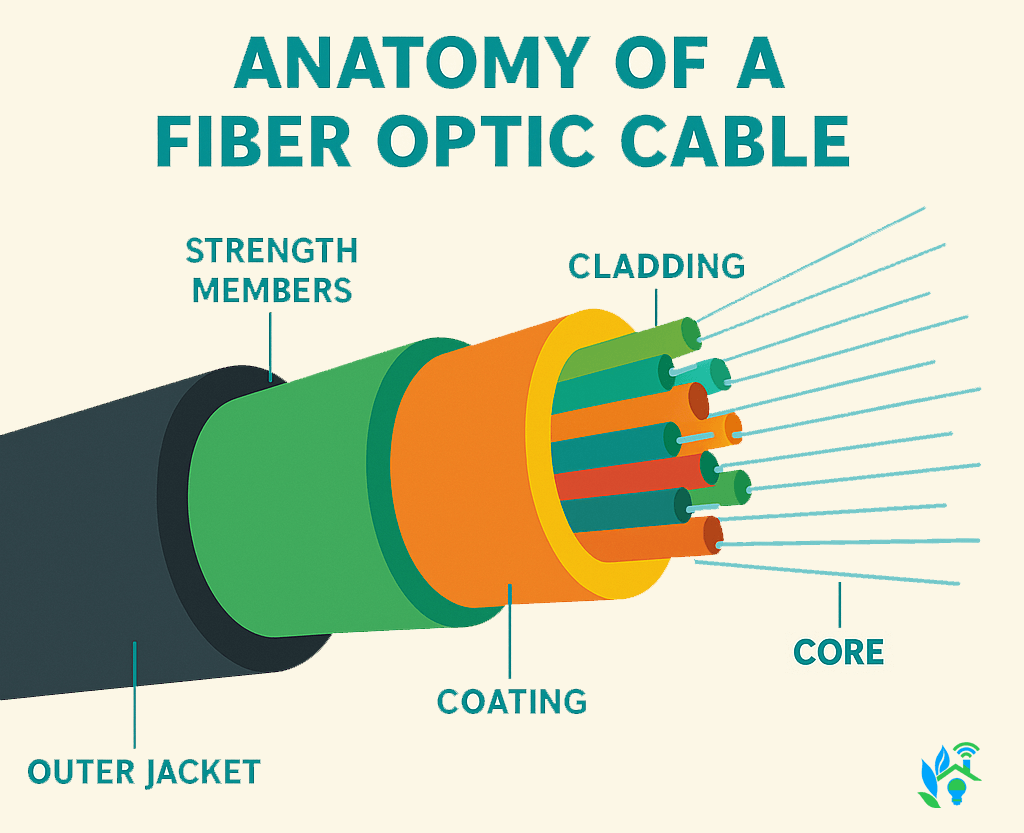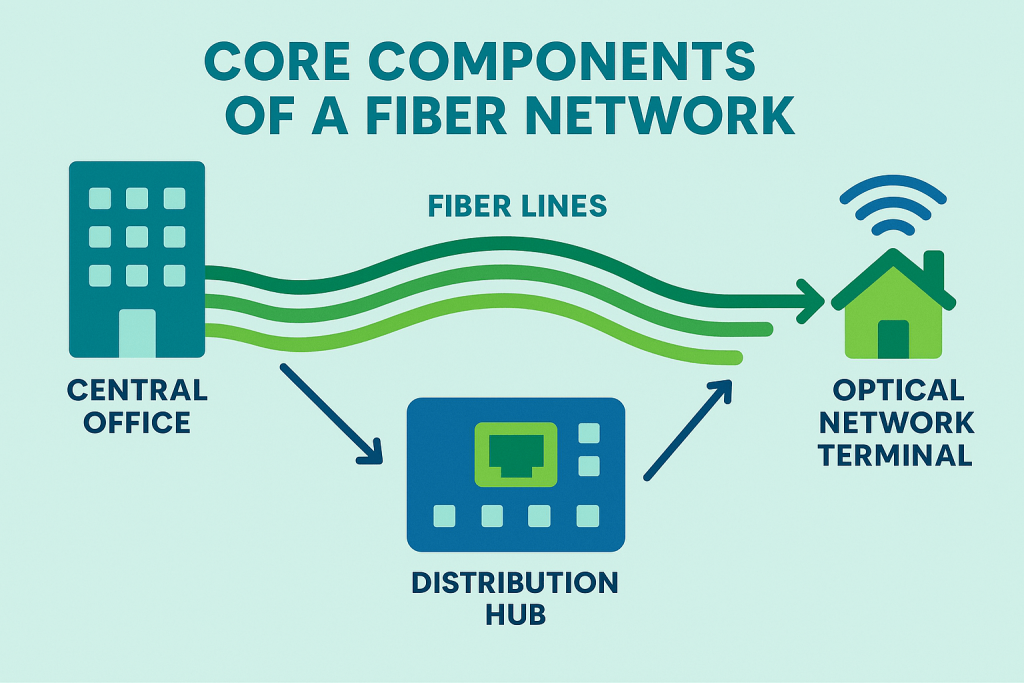Written By: David Cosseboom | Updated On: June 17th, 2025
Popular Fiber Internet Providers
| Speeds: Up to 5 Gbps Starting at: $42/month Availability: 21 States Check Availability |
| Speeds: Up to 2.3 Gbps Starting at: $50/month Availability: 10 States Check Availability |
| Speeds: Up to 8 Gbps Starting at: $70/month Availability: 10 States Check Availability |
Key Takeaways
- With speeds reaching up to 10 Gbps and low latency, fiber offers a smooth and stable connection, making it ideal for streaming, gaming, remote work, and large file transfers.
- While fiber is expanding across the U.S., it’s still not as widespread as cable or DSL, meaning some areas may not have access yet, but the good news is, coverage keeps improving!
- Fiber’s symmetrical upload and download speeds, reliability, and ability to handle multiple devices at once make it a future-proof choice for households and businesses alike. If fiber is available in your area, it’s definitely a strong contender for your internet needs!
What Is Fiber Internet?

Fiber internet is a high-speed broadband technology that uses fiber-optic cables to transmit data as pulses of light. Unlike traditional copper-based connections, fiber offers incredibly fast speeds, low latency, and high reliability. It is widely regarded as the gold standard for internet connections, especially for households and businesses that require robust and consistent connectivity.
Availability in the United States
Fiber internet availability has grown significantly in recent years, with providers expanding their networks to more cities and rural areas. While major metropolitan areas typically have access to fiber from multiple providers, coverage in smaller towns and rural communities is still expanding. Some of the largest fiber providers in the U.S. include AT&T Fiber, Google Fiber, Verizon Fios, and regional providers like Quantum Fiber and Frontier.
T-Mobile has recently launched fiber service in very select areas, but is looking to expand to more cities. Watch for them coming to your neighborhood soon.
Benefits of Fiber Internet
- Blazing Fast Speeds – Fiber internet supports speeds of up to 10 Gbps, far surpassing traditional cable and DSL.
- Low Latency – Perfect for gaming, video conferencing, and cloud applications.
- Reliable Connection – Less susceptible to weather and electromagnetic interference compared to copper-based connections.
- Symmetrical Upload & Download Speeds – Unlike cable and DSL, fiber offers equal upload and download speeds, making it ideal for remote work and content creation.
- Future-Proof Technology – With increasing internet demands, fiber is built to handle high-speed requirements for years to come.
How Fast Is Fiber Internet?
Fiber internet speeds vary based on the provider and plan, but most fiber connections range from 300 Mbps to 10 Gbps. This makes it one of the fastest internet options available, capable of handling multiple devices streaming 4K video, online gaming, large file transfers, and remote work applications without buffering or lag.
How Fiber Internet Works

Fiber-optic internet transmits data using light signals through ultra-thin glass or plastic fibers. These fibers can carry vast amounts of data at high speeds over long distances without signal degradation. The core components of a fiber network include:
- Optical Network Terminal (ONT) – Installed in homes or businesses to convert fiber signals into usable internet.
- Fiber Distribution Hub – A centralized point where fiber lines branch out to individual buildings.
- Central Office (CO) – A major hub where internet traffic is managed before being distributed through fiber lines.
- Backbone Fiber Lines – High-capacity cables that transport data between cities and internet exchange points.
Fiber Internet Installation
Installing fiber internet typically involves a visit from a professional technician who will bring fiber-optic cables directly to your home. This may require running cables underground or overhead, depending on your local infrastructure. Once the fiber line is installed, the technician sets up an Optical Network Terminal (ONT), usually placed inside your home or business, which converts the fiber signal into usable internet. From there, you can connect your router to the ONT to distribute internet access via Ethernet cables or Wi-Fi throughout your property. The installation process can take several hours, and some providers may charge installation fees.
Pros and Cons of Fiber Internet
While fiber internet offers significant advantages, it may not be the best choice for everyone. Its availability is still expanding, which means some areas do not yet have access to it. Additionally, installation costs can be higher, especially if fiber infrastructure is not already in place. Despite these drawbacks, the benefits of faster speeds, reliability, and symmetrical upload and download rates make fiber an excellent option for those who have access to it, especially for work, streaming, and gaming needs.
Pros:
- Ultra-fast speeds and low latency
- More stable and reliable than cable or DSL
- Less congestion during peak hours
- Supports multiple high-bandwidth activities simultaneously
Cons:
- Limited availability in some areas
- Installation costs may be higher than other options
- Not all ISPs offer fiber plans
Fiber vs. DSL vs. Cable Internet
While all three types of internet service provide connectivity, fiber internet stands out for its exceptional speed, low latency, and reliability. Cable internet is a solid option where fiber is unavailable, offering decent speeds but suffering from network congestion during peak hours. DSL, though widely available, is the slowest and most outdated of the three, making it less suitable for modern internet demands such as streaming, gaming, and remote work. If fiber is an option in your area, it’s the best choice for a seamless online experience.
| Feature | Fiber Internet | Cable Internet | DSL Internet |
|---|---|---|---|
| Download Speeds | Up to 10 Gbps | Up to 1 Gbps | Up to 100 Mbps |
| Latency | Very low | Moderate | High |
| Reliability | High | Moderate | Low |
| Availability | Growing | Widely available | Very widespread |
| Upload Speeds | Symmetrical | Lower than download | Much lower than download |
Fiber internet is the fastest and most reliable broadband option available today. While availability is still expanding, it offers numerous advantages over DSL and cable, making it the best choice for households and businesses that need high-performance internet. If fiber is available in your area, it’s definitely worth considering as your primary internet connection!
Fiber Availability by State
| State | Fiber Availability | 1 Gig Fiber Availability |
|---|---|---|
| Alabama | 36.44% | 35.38% |
| Alaska | 8.23% | 5.54% |
| Arizona | 15.11% | 3.91% |
| Arkansas | 41.35% | 40.68% |
| California | 31.56% | 31.25% |
| Colorado | 31.71% | 13.62% |
| Connecticut | 55.73% | 55.17% |
| Delaware | 47.31% | 0.28% |
| District of Columbia | 55.45% | 3.52% |
| Florida | 37.49% | 33.92% |
| Georgia | 43.71% | 43.06% |
| Hawaii | 45.79% | 0.31% |
| Idaho | 25.13% | 16.67% |
| Illinois | 29.5% | 29% |
| Indiana | 45.02% | 44.78% |
| Iowa | 50.49% | 42.36% |
| Kansas | 50.3% | 48.6% |
| Kentucky | 50.55% | 49.9% |
| Louisiana | 30.78% | 29.07% |
| Maine | 33.17% | 31.13% |
| Maryland | 55.43% | 3.07% |
| Massachusetts | 43.6% | 4.37% |
| Michigan | 20.73% | 20.39% |
| Minnesota | 37.02% | 27.03% |
| Mississippi | 46.35% | 46.19% |
| Missouri | 41.61% | 40.2% |
| Montana | 25.45% | 18.17% |
| Nebraska | 59.48% | 46.28% |
| Nevada | 20.5% | 8.23% |
| New Hampshire | 45.05% | 44.92% |
| New Jersey | 59.43% | 21.62% |
| New Mexico | 16.46% | 14.68% |
| New York | 59.94% | 48.15% |
| North Carolina | 37.55% | 35.8% |
| North Dakota | 61.41% | 58.68% |
| Ohio | 37.04% | 35.44% |
| Oklahoma | 43.82% | 42.75% |
| Oregon | 39.42% | 24.99% |
| Pennsylvania | 45.14% | 8.01% |
| Puerto Rico | 48.35% | 48.35% |
| Rhode Island | 76.13% | 0% |
| South Carolina | 40.76% | 37.01% |
| South Dakota | 49.55% | 43.41% |
| Tennessee | 53.06% | 52.86% |
| Texas | 45.31% | 44.75% |
| Utah | 52.28% | 44.94% |
| Vermont | 39.24% | 37.76% |
| Virginia | 50.91% | 10.91% |
| Washington | 30.53% | 18.39% |
| West Virginia | 23.14% | 20.48% |
| Wisconsin | 31.76% | 30.27% |
| Wyoming | 25.32% | 24.67% |
FAQs about Fiber Internet
How does fiber internet compare to cable and DSL?
Is fiber internet available in my area?
Do I need special equipment for fiber internet?
Is fiber internet worth the cost?
Does weather affect fiber internet?
My fiber internet is totally down, no lights on the modem. What should I do?
Why is my fiber internet so slow?
My internet keeps dropping! How do I fix it?
My ONT has a scary red light, what does it mean?
Pro tip: Never try to splice fiber yourself, it’s like brain surgery for cables!
Why is my ping so high?
Pro tip: Some routers have a “Gaming Mode” to prioritize traffic, check yours!
About the Author
David has been an integral part of some of the biggest utility sites on the internet, including InMyArea.com, HighSpeedInternet.com, BroadbandNow.com, and U.S. News. He brings over 15 years of experience writing about, compiling and analyzing utility data.
